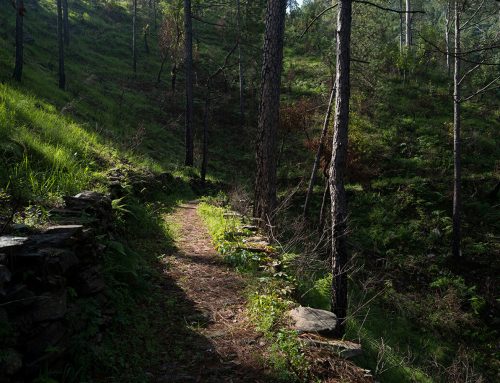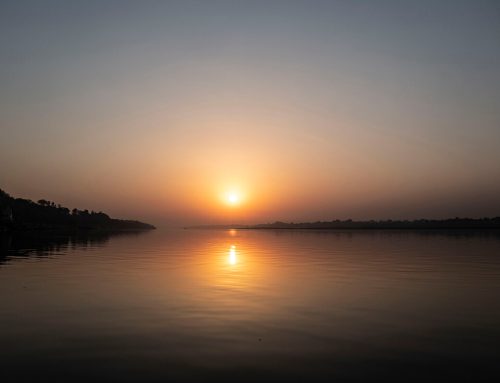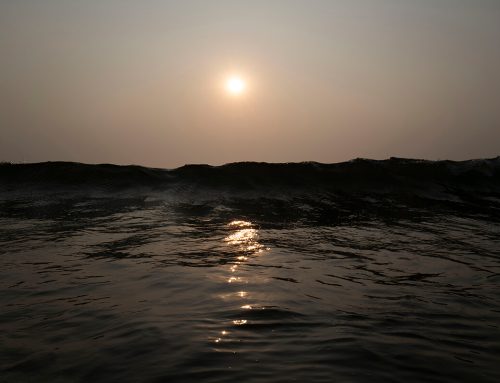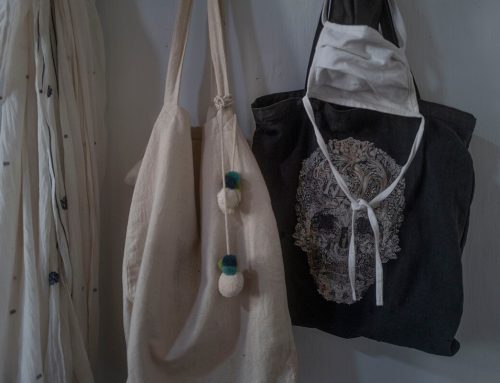Leaving London, studying at the Ramamani Iyengar Memorial Institute in Pune, cancelling the Goa TTC as Covid-19 becomes a global pandemic, sunsets and strategies to cope with lockdown in India.
Photographs and text by Heather Elton
 Statue of Patanjali at the Ramamani Iyengar Memorial Institute in Pune.
Statue of Patanjali at the Ramamani Iyengar Memorial Institute in Pune.
IN JANUARY 2020, I PULL THE RUG OUT FROM UNDER MY COMFORT ZONE AND LEAVE LONDON. I sell my possessions, put things I still can’t part with in storage, leave my home of 20 years, to travel in India. I think of it as a form of renunciation to live a more nomadic life. I want to be less entangled with the material world and have more time for spiritual practice. It’s a leap of faith to follow my heart.
I arrive in Pune to study at the Ramamani Iyengar Memorial Institute (RIMYI), the hallowed halls of yoga guru BKS Iyengar. A dream since the 80s, I’m finally here with a few yoga pals from London. RIMYI is impressive and offers about 12 daily classes, patronised daily by over 400 Indian students, of all ages, who have practiced here for decades. Since the passing of BKS Iyengar and his daughter Geeta, the school is under the direction of his granddaughter, Abhijata. She is a formidable female yogini with the presence of Geetaji, but is contemporary, well-educated, well-spoken and has a sense of humour. BKS apparently poured all his knowledge into his granddaughter and she is the good container for his teachings. Her classes are a mix of precise asana technique and yoga philosophy. Prashant Iyengar, BKS’s brilliant and tragic son, who is now in his seventies, is a deep thinker and an inspiring teacher, especially the pranayama and philosophy teachings as applied to asana and an investigation into the mind. Medical classes are held in the afternoon where certified Iyengar teachers study ‘yoga therapy’ and use asana to help with serious medical conditions. We can audit as many classes as we like, but can only do one ‘class’ a day.

Photos of BKS Iyengar on the walls inside the Ramamani Iyengar Memorial Institute (RIMYI) in Pune.
In addition to the one class and auditing others, I do self-practice in the vintage yoga shala adorned with B&W photos from the sixties of Iyengar doing advanced asana. The classical wooden props and hanging ropes that BKS Iyengar is famous for help me to be in a ‘state of yoga’ that is inherently still and blissful!
Towards to the end of February, COVID-19 suddenly become a serious threat. Foreigners are screened at the Pune airport. A group of Iyengar students from China are quarantined. The Institute closes its doors in the interest of containment and safety. Maharashtra state has the highest number of cases in India. 1,957 cases and 160 deaths. We are some of the last students to leave Pune.

Photos of BKS Iyengar on the wall inside the Ramamani Iyengar Memorial Institute (RIMYI) in Pune.
I take a night bus to Goa, which is pleasant once I actually get on the bus, into my berth, and fall asleep. The getting-out-of-Pune-onto-the-highway-to-catch-the-bus episode is challenging, with bad roads and honking vehicles spewing exhaust. Everyone is on the phone. It’s a hell realm of chaotic capitalism. I look forward to a quiet week on the beach in Goa prior to start of my Goa TTC.

Student yoga mat with teaching materials for the Goa Yoga Teacher Training.
COVID Phase 1
M O R J I M B E A C H
G O A
The yoga venue that I booked is not ready. Construction is still underway at the venue (despite the images they sent a couple weeks back assuring me it was finished!!) and the rooms are too small for students to share for a month. Lesson (that I’ve already learned in the past): NEVER book a yoga venue you’ve never seen! Especially if you’ve known the owner for over a decade. I have no option but to teach at his other venue, on Morjim Beach, one of the most beautiful beaches in Goa, except that it’s overrun by Russian mafia and partygoers. Loud, blaring techno music, 24/7. Not ideal for a yoga training and a place I’ve avoided for the past 12 years of teaching in Goa. As circumstances would have it, we are here.

Students practising Sirsasana with a 3-fold blanket on the Goa TTC.
Two students have cancelled due to Coronavirus. The other twelve who arrive are calm, settling in nicely and seem interested in my yogic teachings, but in Week 3 when they are most likely to lose any newly-established Santosha, and have a chance to work with what comes up, especially aversions to things they don’t like – and there can be many when you’re in a foreign country, sharing a room with a stranger – suddenly, the virus escalates into a ‘pandemic’.
Narendra Modi announces that international flights will be cancelled in the coming days. Panic sets in and any yoga-off-the-mat techniques fly out the window. Students are understandably anxious and become absorbed, not in Samadhi, but in making arrangements to get home. Coronavirus dominates our existence. Everyone is highly distracted and not present. It’s almost impossible to teach. One by one they leave. There is a mass exodus of foreigners from Goa. My co-teacher takes a flight back to the US. I hold space for the few who remain until the end. I feel like the captain of a sinking ship.

Viparita Dandasana. I teach as much restorative yoga as possible within the structure of the curriculum to help people remain calm as Covid is elevated to a ‘pandemic’.
On March 24, 2020, the Modi government declares one of the harshest lockdowns the world has seen that lasts 21 days. Overnight, all businesses close their doors, including spas and yoga retreats (the latter have yet to open 14 months later). We are under strict curfew and lockdown, unable to leave the premise except for essential things. It happens so fast that people have no time to stock up on food. Police roam the streets and arrive on the beaches via helicopter, intimidating and beating anyone they find with bamboo lathes and a warning that next time they will go to jail. Goa turns into a police state and everyone is confused and fearful. Stories surface about people not eating for days and the treatment of foreigners in India is dire. Tourists are thrown out of guesthouses and pulled off buses in Manali. Fortunately, Goa has had a good relationship with tourists for decades. Tourism is a big part of the economy, but still the flat I’d agreed to rent in April falls through when the owner tells me he’s no longer renting to foreigners. There is a persistent belief that foreigners brought Covid to India.

Police patrol the beach asking people to go home. The lifeguards are called DRISHTI, a term used in yoga practice to mean ‘gaze.’ We focus on a part of the body to enhance concentration (Dharana) of the mind.
I stay on at the yoga resort. There are four of us here – a yoga teacher from London (whose retreat has also been cancelled), two yogis from Argentina who are kirtan singers. A lovely yogini from Norway (who is a brilliant body therapist) and a photographer from Uzbekistan trying to get back to LA. We each have our own room and meet in a communal area for meals and long discussions about Covid-19. My companions are skeptical about the seriousness of the disease and worried about encroaching government tyranny. Fortunately, the venue is large and so we can be outside without having to leave the premises. The swimming pool becomes a priority since the beach is now ‘off limits’. Food is still prepared for us – a simple meal of rice, dal, veg and chapati, but the quality and variety of food declines. The grounds are lush with banana trees and exotic flowers and birds. Sadly, within a few weeks the pool turns algae green. We do our best to use our yoga skills to maintain calmness. Equanimity.

My self-isolation room for three months in Morjim, Goa.
Since I have locked myself down in the past on various retreats the new situation is not that difficult for me. But there are a lot of people who are suffering, especially those with large families who aren’t allowed to leave the house. In India, social distancing is a privilege. It’s a luxury most people can’t afford. My room is large enough to practice asana and I spend much time on the mat. Late afternoons, I teach yoga philosophy to my Covid sangha. One perspective I share is that yoga is a science to control the mind. According to Patanjali (not that I consider him to be the most important philosopher), Citta Vrtti Nirodha is what happens when yoga is attained. The cessation of fluctuations in the mind that propel us into the past, rewriting our own history, or into the future where we spend countless hours imagining things that never come to pass, allows us to come to a place of quiet, calm awareness and total presence. Equanimity no matter what. So, in a sense, the pandemic provides the substance for deep practice by challenging this very principle.
I took refuge in the Buddha a decade ago, so know about concepts of impermanence and change, but here I am truly embodying the essence of those teachings. This situation that we’re going through at the moment really makes us see how insignificant we are actually. Many times we forget that. We think that we can control our life. But this is not the case and the pandemic is definitely something unfamiliar to us, so that’s why we all feel anxious. We really don’t like unfamiliarity? I watch my plans dissolve as I stare at naked uncertainty.
Last week, I was supposed to be in Bhutan leading a Himalayan Yoga Adventure. The Ladhak Yoga Adventure in July is now cancelled. Who knows if the Yoga Adventure in Bhutan in September and the Nepal TTC in October will happen? Impermanence might be thrust upon us by the global pandemic, but Gautama Buddha pointed this out when he ‘awoke’ under the Bodhi tree. Now samsara is a tangible presence in our lives. We hate uncertainty, yet this is what is being asked of us. My Tibetan Guru, Dzongsar Jamyang Khentsye Rinpoche, says the best thing we can do right now is NOT make plans. That becomes my mantra.
While there are days where I feel vulnerable and shaky (especially venturing back out in the world after a month of isolation), I choose to meet adversity; not escape or bypass it, but feel it, allow it, and embody it. I practice a Yoga Sequence for Immune Support that leaves me feeling grounded and calm. I’ve always done everything possible to enhance my immune system, but it seems especially important now. I take my Vitamin B, C, D, zinc and magnesium, probiotics, turmeric and ginger, and some Ayurvedic immune enhancing substance. And shilajit, the Himalayan superfood. I post the Yoga Sequence for Immune Support sequence on my YouTube channel to boost immunity and help diminish anxiety and stress. Poor wifi makes connection with the outside world random and live classes on Zoom impossible.
I also create a series of poolside videos, readings from an article I wrote for the ‘Shakti Issue (26 Winter)’ of Namarupa, the magazine for Classical Indian Thought in New York. The Goddess Episodes discuss the ancient roots of goddess worship in India, evidence in ancient texts, Hindu myths pertaining to Sati, Durga and Kali. And my Pilgrimage to Shakti Peeths in the legendary tantric heartland of West Bengal. It’s time to embrace the Goddess, the Mother.

Sometimes I feel pretty shaky in this new pandemic life, staring at naked impermanence and uncertainty, alone in a foreign country without family, friends, or a home. My tenuous existence seems hung together by witnessing the daily sunsets. Mainstream media spreads a narrative of disaster and fear. I delve into #lifeafternetflix.
Thirty-two staff members are also staying at the yoga resort, migrant workers from other Indian states. They tell us that my owner/friend has not paid them all season and they have no money to get home. Word comes out about how lockdown has affected the plight of migrant workers in India, tens of thousands of people in dire poverty, living hand to mouth, their ability to make money terminated, and with no support from the government, and few buses and trains operating, they have no choice but to begin the long, punishing walk back to their villages, in 50 degree heat, with little food, carrying their homes on their backs. There is tremendous suffering and many die on the way.
I paid the yoga venue £12,000 a few weeks ago for the TTC, and continue to pay £500 per month in rent (very expensive for Goa) and goes a long way in India, yet there is no cash flow and food begins to run out. We are served the worst Monsanto-grown produce from Maharastra and I barely eat. I sponsor five staff members to get home to Agra, giving them money for a train ticket and food. I’m appalled that despite making tens of thousands of dollars from international yoga teachers that the management has neglected to pay their staff, in the name of ‘yoga’. My ongoing crisis about the neo-libertarian state of commercial yoga deepens. I vow never to return to this venue (my original intention at the start).

An empty Morjim beach during the lockdown in Goa.
Despite being across the street from the Arabian Sea I haven’t left the venue in over a month. As a guest in a foreign country, I do my best to obey the rules. But by mid-April, the temperature is 45 degrees with 86% humidity and the pool not swimmable, I cautiously leave the resort, walk past the small shops wrapped in tarp, and find myself alone on a deserted beach. No drunken party-revellers, restaurants blaring loud techno trance, or sun beds littering the beach. A natural beach in its sublime beauty where I can hear the comforting sound of the waves crashing to shore. I imagine this is what Goa must have been like when the first hippies arrived in the late ’60s. I need to be careful as police and the lifeguards patrol the beach and if they see anyone, tell us to go home.
A beach has to be the safest place to be during Covid-19. Sunlight is essential both for mental health and to absorb Vitamin D. The beach is ultimate social distancing. I’m magnetised as the sun sinks beneath the horizon, turning the water mercurial silver with hues of pink. Time is eaten before my eyes. The simple act of witnessing one day moving into the next becomes a ritual that connects me to the rhythms of the earth – the absolute backdrop underlying the temporary pandemic – and helps me maintain equanimity in these confusing times. It creates a kind of order to life that I imagine is similar to the idea or ‘Ṛta’ (order, truth) in the Vedas where people prayed to Surya, the Sun God, to appear each day. This principle of natural order regulates and coordinates the operation of the universe and everything within it. The rhythm of Nature brings me into the present moment. I feel such ‘awe’ in the presence of beauty that I forget myself, the politics and narratives that whip up my mind, and simply be. Nature is the ultimate force that restores balance in my life. I’m so grateful to have found myself in her embrace.
 A visit to Aswem Beach with Rebecca Godvibber during lockdown in Goa.
A visit to Aswem Beach with Rebecca Godvibber during lockdown in Goa.
Each day, I steal precious moments to immerse myself in the vast energy of the sea. I float on my back, effortlessly, giving myself entirely to the universe. Overhead, 20 eagles ride the wind currents. I feel like a bird, my arms outstretched, both of us suspended, gracefully, it by wind, me by water. Absolute bliss! I am wholeheartedly embracing the five elements, or Maha Bhutas, as they are referred to in early yoga philosophy like Samkhya – Space (Akash), Air (Vayu), Fire (Agni), Water (Jal), Earth (Prithvi) – energies that reside within our chakras. They are the essence of life on the planet. Whatever happens to them happens to us. If these energies that reside within our chakras are out of balance we become ill. Tibetan buddhist believe that the wind element (lung) is associated with our lungs, and is connected to mental illness. Consciousness rides upon the winds. And these winds – vayus – need to be tamed gently, like a tiger, or they will kill us. The relationship we have with the elements affects us.
The Tanmatras connect the outer world of the five elements to the intermediary senses objects, and to consciousness. I listen to hear the infinite vibration of space, touch the wind, absorb the heat of the sun and with it ignite my sense of sight, drink in the taste of water, and smell the fragrance of earth. My senses connect to the elements through which they create form in the outer world. Pratyahara draws the senses back inside towards pure consciousness. All outer and inner forms are comprised of the five elements. I am filled with prana and vitality. I’m also aware that this fragile construction of reality is unique to each of us, depending on where we live and the circumstances of our lives. I’m very privileged to have Nature as my primary backdrop for the pandemic. It’s the grace of my gurus.

I’m magnetised as the sun sinks beneath the horizon. Time is eaten before my eyes. The simple act of witnessing one day moving into the next becomes a ritual that connects me to the rhythms of the earth – the absolute backdrop underlying the temporary pandemic – and helps me maintain equanimity in these confusing times.
I’m saddened by the suffering caused by Covid-19 and lockdown, and the possible end of life as we knew it, but I love that the earth is finally able to rest. Polluting industries have shut down, and our compulsive need to consume lies dormant. Dolphins are back swimming in Venice canals and the Himalayan peaks can be seen again in KMD like they were in the ’80s. Nature’s ability to renew herself is inspiring and hopeful, like grass appearing five weeks after Hiroshima. I wonder if the pandemic is offering us a chance to live a more balanced life in harmony with nature. My guru believes that the pandemic arose out of humanity’s abuse of the earth and disrespect of the feminine. When we harm the earth we harm ourselves. If we pollute the elements consequences will happen. The earth is suffocating. I do a Vajrayana sadhana with the intention to purify the toxic elements that are polluting the five elements and restore the feminine to her rightful place. The pandemic gives us time for reflection about what kind of world we really want to live in.

Storms can be intense on the beach and it will rain steadily for a month or two with cloudy skies. Strong currents make the sea unsafe to swim.
As monsoon threatens to arrive with intense winds and rain, the oil tankers offload crude into the Arabian Sea. Creosote is washed up on the sand and strong currents make swimming unsafe. There is an infiltration of jellyfish, a symptom of a dying sea. Billionaires are profiting from the pandemic, the industrial world reopens and mining reaches epic proportions in India. I’m sickened by death of George Floyd and overt racism in the USA, shocked to see the emergence of fake news, encroaching censorship and the control of big tech, the polarisation of views in the media that spreads fear and hate in the world. This is a time when we should find unity and come together in the face of the pandemic, yet the opposite appears to be happening. I hope that the anger and anguish from the #Black Lives Matter protests will result in positive change and justice for ALL. Long overdue. Ahimsa, non-violence, is the main tenant of yogic practice.
My yogi pals leave Goa before monsoon. I still feel blessed to be here. When one thing dissolves, another arises. I’m offered a beautiful house in Assagao, the posh Portuguese neighbourhood close to Anjuna. My friend is stuck in Argentina and needs someone to look after his 13-year old dog. Before I leave Morjim, I hang prayer flags on a large Ponderosa Pine tree, at the edge of the forest, looking out to Chapora River and the sea. I honour the past three months of precious time in lockdown, give thanks for the protection I’ve received, for the wisdom embodied through yoga practice, and for the blessings of Nature, that has given me a sense of structure and order, in this chaotic, dark and confusing time. I send prayers that all sentient beings are free from suffering. ♦
Read Part Two – My Pandemic Life in India: Assagao
In January 2020, I pulled the rug out from under my comfort zone and left London to live in India. A month later the Covid pandemic ravaged the planet. I decided to stay in India. Photography, travelogue and memoir is used to share my experience as a travelling yogini and how spiritual practice helped me to stay grounded in challenging times. As always, deep gratitude to my guru, Dzongsar Jamyang Khentsye Rinpoche, for his presence and teachings. 🙏🏽 Any misrepresentations of facts or dharma are totally of my own doing for which I’m sorry.





